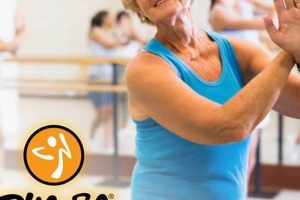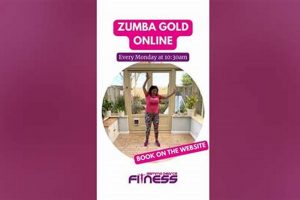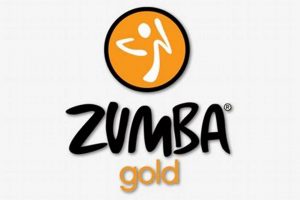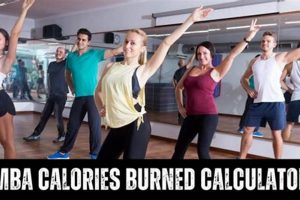This specialized fitness program modifies the traditional Zumba dance workout to cater to active older adults and beginners. It focuses on low-impact movements, easy-to-follow choreography, and a slower pace, ensuring participants can comfortably engage while improving cardiovascular health, balance, coordination, and flexibility. For example, high-energy jumps are replaced with gentler steps, and complex routines are broken down into simpler, manageable sequences.
The value of this approach lies in its accessibility and effectiveness in promoting physical and mental well-being for individuals who may find standard Zumba classes too strenuous. Its emergence reflects a growing recognition of the importance of tailored fitness solutions for specific demographics, acknowledging the unique needs and capabilities of older adults. Regular participation contributes to enhanced mobility, reduced risk of falls, and increased social interaction, fostering a sense of community and improved quality of life.
The following sections will delve into the specific adaptations made in the program, the qualifications and training required for instructors, and the positive impact it has on participants’ overall health and wellness.
Guidance for Effective Instruction
The following guidelines are crucial for instructors seeking to deliver a safe, effective, and engaging exercise experience. These recommendations emphasize adaptations and considerations necessary for accommodating diverse fitness levels and needs.
Tip 1: Prioritize Low-Impact Modifications: Emphasize movements that minimize stress on joints. Replace jumping or high-impact steps with marching, stepping side-to-side, or gentle swaying. Modifications ensure accessibility for individuals with arthritis or mobility limitations.
Tip 2: Simplify Choreography: Break down complex routines into smaller, more manageable segments. Focus on repetitive patterns that are easy to learn and remember. Avoid intricate footwork or rapid transitions that could lead to confusion or injury.
Tip 3: Maintain a Slower Pace: Adjust the tempo of the music to allow participants sufficient time to execute movements correctly and safely. A reduced pace enables better coordination and reduces the risk of overexertion.
Tip 4: Provide Clear and Concise Cues: Use unambiguous verbal cues to guide participants through each movement. Demonstrate each step clearly and provide visual cues to reinforce understanding. Offer modifications and options for different ability levels.
Tip 5: Monitor Participant Form and Provide Individualized Feedback: Observe participants closely to ensure proper form and technique. Offer gentle corrections and encouragement to prevent injuries and promote effective movement patterns. Be mindful of individual limitations and adjust exercises accordingly.
Tip 6: Encourage Hydration and Rest: Remind participants to drink water regularly throughout the session. Incorporate brief rest periods to allow for recovery and prevent fatigue. Create a supportive and non-competitive environment where individuals feel comfortable taking breaks as needed.
Adhering to these tips ensures a safe, enjoyable, and beneficial experience for all participants, maximizing the positive impact on their physical and mental well-being.
The subsequent sections will explore specific exercises suitable for this population, along with strategies for creating inclusive and motivating class environments.
1. Low-impact modifications
Low-impact modifications are fundamental to the design and execution of this specialized fitness program. These adaptations address the physiological needs and limitations often associated with aging or deconditioned states, ensuring accessibility and safety for a broader range of participants.
- Joint Protection
The primary objective of low-impact alternatives is to minimize stress on joints, particularly the knees, hips, and ankles. Traditional Zumba movements often involve jumping, high-impact landings, and rapid changes in direction, which can exacerbate pre-existing conditions such as osteoarthritis. Modifications replace these movements with gentler alternatives, such as marching in place or stepping side-to-side. For example, instead of a jump squat, participants perform a modified squat with feet remaining firmly planted on the ground. This approach reduces the compressive forces on joints, decreasing the risk of pain and injury.
- Cardiovascular Safety
Low-impact exercise allows individuals to elevate their heart rate and improve cardiovascular fitness without the strain associated with high-intensity activities. By maintaining continuous movement without jarring or sudden stops, participants can achieve a sustained aerobic effect. For example, instead of sprinting intervals, participants engage in brisk walking or sustained marching. This approach is particularly beneficial for individuals with hypertension or other cardiovascular concerns, as it provides a safer and more controlled means of improving heart health.
- Balance and Stability
Modifications frequently incorporate exercises that enhance balance and stability, crucial for preventing falls in older adults. Low-impact versions of dance steps often involve wider stances, slower movements, and increased awareness of body position. For example, instead of a quick salsa step, participants perform a modified step with a focus on maintaining a stable center of gravity. These adaptations improve proprioception, strengthen stabilizing muscles, and reduce the likelihood of falls, contributing to enhanced independence and overall quality of life.
- Muscle Engagement
Low-impact modifications maintain muscle engagement while minimizing joint stress. These variations often emphasize controlled movements and proper form, promoting strength and endurance without risking injury. For example, arm movements are modified to use resistance bands or light weights. These adaptations can involve slower, controlled movements that target specific muscle groups, like biceps curls or lateral raises. This promotes muscular strength and endurance, which helps with activities of daily living.
The integration of low-impact modifications transforms standard Zumba into an inclusive and effective fitness solution. These adaptations ensure that individuals of varying ages and abilities can safely participate, experience the physical and mental benefits of exercise, and improve their overall well-being.
2. Simplified choreography
Simplified choreography is a cornerstone of this fitness approach, directly impacting participant engagement, safety, and overall efficacy. It distinguishes the program from standard Zumba by intentionally reducing complexity and increasing accessibility for individuals with varying levels of physical fitness and cognitive abilities.
- Reduced Cognitive Load
Simplification minimizes the mental effort required to learn and execute dance routines. Complex step patterns and intricate transitions are replaced with repetitive, predictable movements. This allows participants to focus on physical execution and enjoyment rather than struggling to memorize sequences. For example, instead of a combination of grapevine steps and turns, a class might feature a simple side-to-side step repeated multiple times. This reduction in cognitive demand allows for greater participation and reduces frustration, particularly for individuals with age-related cognitive decline.
- Enhanced Motor Learning
The use of simplified movements promotes motor learning by emphasizing repetition and gradual progression. Routines are broken down into smaller, more manageable units that can be mastered incrementally. This allows participants to develop muscle memory and improve coordination over time. A common example is teaching a basic salsa step first, then gradually adding arm movements as participants become comfortable. This approach fosters a sense of accomplishment and reinforces positive motor patterns.
- Increased Physical Safety
Simplified choreography reduces the risk of injury by minimizing the potential for missteps and falls. Complex footwork and rapid changes in direction are replaced with slower, more deliberate movements. This allows participants to maintain better balance and control, particularly crucial for older adults who may have decreased stability. For example, complicated turns are replaced with simple pivots or side steps. The emphasis on controlled movements reduces the likelihood of strains, sprains, and other injuries.
- Improved Inclusivity and Engagement
Simplified choreography fosters inclusivity by making the program accessible to a wider range of participants, including those with physical limitations or limited dance experience. By removing barriers to participation, it creates a more welcoming and supportive environment. For example, classes incorporate modifications for individuals with mobility issues, allowing them to participate at their own pace and comfort level. This promotes a sense of community and encourages sustained engagement in the program.
These facets of simplified choreography collectively contribute to the effectiveness and appeal of the fitness program. By prioritizing accessibility, safety, and cognitive ease, this approach creates a fitness experience that is both enjoyable and beneficial for a diverse range of participants, promoting sustained engagement and improved overall well-being. The effectiveness hinges on its ability to reach an aging or beginner fitness demographic by meeting them at their current physical and mental capacity.
3. Slower Tempo
A reduced tempo forms an essential adaptation within the framework of fitness programs aimed at older adults and beginners. This deliberate modification addresses specific physiological considerations and contributes significantly to the safety, effectiveness, and overall enjoyment of the exercise experience.
- Enhanced Coordination and Balance
A slower pace allows participants ample time to process instructions and execute movements with greater precision. This is particularly crucial for individuals who may experience age-related declines in motor skills or balance. For example, instead of rapidly transitioning between steps, participants are given time to establish a stable base of support before initiating the next movement. This improved coordination reduces the risk of falls and promotes greater confidence in performing exercises.
- Improved Cardiovascular Control
A moderated tempo allows for a more gradual increase in heart rate and blood pressure, providing better cardiovascular control. This is particularly relevant for individuals with pre-existing cardiovascular conditions. Sustained, moderate-intensity exercise is safer than high-intensity bursts, allowing for improved stamina and heart function. Heart rates will be measured, documented and evaluated for optimization for the individual.
- Greater Joint Protection
Slower movements reduce the impact on joints, particularly the knees, hips, and ankles. This is crucial for mitigating pain and preventing injury in individuals with arthritis or other joint-related conditions. For example, movements can be adapted to avoid sudden stops or weight changes.
- Increased Cognitive Processing Time
A reduced speed gives participants additional time to process and understand instructions. The cognitive processing load can be challenging for some users, so it is imperative that the instructions are delivered slowly for maximum benefits. The increased processing time promotes better comprehension, improved adherence to the program, and a greater sense of accomplishment.
The deliberate implementation of a slower tempo enhances safety, improves motor control, and promotes cardiovascular well-being. By adapting the pace to meet the specific needs of the target population, the result is a fitness experience that is both effective and enjoyable, contributing to improved health outcomes and enhanced quality of life.
4. Clear cueing
Clear cueing serves as a vital component in specialized fitness programs, particularly within the context of modified dance exercise. The relationship is causal: the absence of clear guidance directly impedes participant comprehension and execution, leading to potential safety risks and diminished engagement. This practice involves using precise, concise instructions to guide participants through each movement, ensuring proper form and technique. For example, an instructor may verbally announce, “Step to the right, then touch your left foot in,” while simultaneously demonstrating the action. This immediate visual and auditory reinforcement allows participants to anticipate the movement, promoting accurate replication and minimizing confusion.
The importance of clear cueing extends beyond basic instruction; it addresses the diverse needs and abilities of the target demographic. Older adults, for instance, may experience age-related declines in auditory processing or motor coordination, requiring more explicit and deliberate guidance. Instructors use visual aids and repetition to reinforce cues, and physical touch is used only with consent. Another example is an instructor providing a countdown before a change in step or a verbal prompt that repeats the count so each of the participants can follow the routine successfully. This strategy allows the participants to anticipate and synchronize their movements with the instructor, improving overall class flow and reducing potential for error.
In summary, the understanding and implementation of clear cueing techniques directly enhance the effectiveness and safety of modified dance fitness. The connection is practical and essential, as the quality of instruction significantly impacts participant experience and outcomes. Challenges exist in adapting cueing strategies to accommodate varying cognitive and physical abilities within a group, but these are mitigated through ongoing instructor training and awareness. Clear and intentional cueing ensures inclusivity and promotes safe and fun workouts for the participants.
5. Social Engagement
Social engagement is an integral component of the Zumba Gold program, contributing significantly to participant adherence and overall well-being. Its inclusion moves beyond simple physical exercise, fostering a sense of community and mutual support among participants. This element directly addresses potential social isolation, a concern particularly relevant for older adults, and provides a structured environment for positive social interaction. For example, regular class attendance provides opportunities for participants to form friendships, share experiences, and build supportive relationships, leading to improved mental and emotional health outcomes.
The program’s design often incorporates activities that promote interaction, such as partner dances, group exercises, and post-class social gatherings. Instructors are trained to facilitate a welcoming and inclusive atmosphere, encouraging participants to connect with one another and celebrate their achievements. The resulting sense of belonging and shared accomplishment enhances motivation, encouraging continued participation and adherence to the exercise program. Furthermore, instructors may organize additional events, such as potlucks or outings, further solidifying social bonds and extending the benefits of social engagement beyond the classroom setting. These social connections directly improve commitment, health and the lives of each of the participants, in addition to simply exercise.
The understanding of social engagement’s impact is essential for instructors and program developers. Recognizing that the benefits extend beyond physical fitness allows for a holistic approach to program delivery, emphasizing both exercise and community building. While challenges exist in fostering social connections among diverse individuals, the structured nature of the classes, coupled with deliberate efforts by instructors, promotes a supportive environment. In essence, social engagement transforms the program from a solitary activity into a community-driven experience, enhancing its impact on participant health and quality of life.
Frequently Asked Questions About Zumba Gold Training
This section addresses common inquiries and clarifies misunderstandings surrounding this fitness regimen. It provides objective answers to assist in informed decision-making regarding participation.
Question 1: What distinguishes Zumba Gold training from standard Zumba?
This fitness program is a modified version of traditional Zumba, designed to accommodate active older adults and individuals new to exercise. It features low-impact movements, simplified choreography, and a slower tempo, prioritizing safety and accessibility.
Question 2: What are the primary benefits of participating in Zumba Gold training?
Regular participation offers several advantages, including improved cardiovascular health, enhanced balance and coordination, increased flexibility, and reduced risk of falls. Furthermore, it promotes social interaction and mental well-being.
Question 3: Are there any prerequisites for joining Zumba Gold training?
No prior dance experience or exceptional fitness level is required. The program is designed to be inclusive, catering to individuals of varying abilities and physical conditions. A consultation with a healthcare professional is advised before starting any new exercise program.
Question 4: What type of clothing and footwear is recommended for Zumba Gold training?
Comfortable, breathable clothing that allows for a full range of motion is recommended. Supportive athletic shoes with good traction are essential for preventing slips and falls. Avoid footwear with excessive cushioning or high heels.
Question 5: Is Zumba Gold training safe for individuals with pre-existing medical conditions?
While the program is designed to be low-impact and safe, individuals with pre-existing medical conditions, such as arthritis, heart disease, or diabetes, should consult with their physician before participating. Modifications can often be made to accommodate specific limitations.
Question 6: How can one locate certified Zumba Gold instructors and classes?
Certified instructors can be located through the official Zumba website’s instructor directory. Local community centers, gyms, and senior centers also frequently offer classes. Verification of instructor certification is recommended to ensure qualified guidance.
These frequently asked questions highlight the key aspects and considerations associated with participation. A thorough understanding of these points is crucial for maximizing the benefits and minimizing potential risks.
The following section will provide guidelines for effective participation and injury prevention.
Conclusion
This exploration of Zumba Gold training has highlighted the crucial adaptations and considerations necessary for delivering a safe and effective fitness experience for active older adults and beginners. Key components, including low-impact modifications, simplified choreography, a slower tempo, clear cueing, and social engagement, are fundamental to the program’s success in promoting physical and mental well-being. Proper implementation of these elements is essential for minimizing risk of injury and maximizing the positive impact on participants’ health and quality of life.
The continued growth and adoption of Zumba Gold training underscores the importance of tailored fitness solutions that address the unique needs of specific populations. By prioritizing accessibility, safety, and community, this program contributes significantly to promoting active aging and enhancing the overall wellness of its participants. Further research and development in this area are warranted to refine best practices and expand the reach of this valuable fitness resource.







